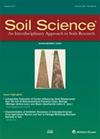Effects of a warmer climate and forest composition on soil carbon cycling, soil organic matter stability and stocks in a humid boreal region
4区 农林科学
Q2 Agricultural and Biological Sciences
引用次数: 0
Abstract
Abstract. The maintenance of the large soil organic carbon (SOC) stocks of the boreal forest under climate change is a matter of concern. In this study, major soil carbon pools and fluxes were assessed in 22 closed-canopy forests located along an elevation and latitudinal climatic gradient expanding 4 ∘C in mean annual temperature (MAT) for two important boreal conifer forest stand types: balsam fir (Abies balsamea), a fire avoider, and black spruce (Picea mariana), a fire-tolerant species. SOC stocks were not influenced by a warmer climate or by forest type. However, carbon fluxes, including aboveground litterfall rates, as well as total soil respiration (Rs) and heterotrophic (Rh) and autotrophic soil respiration (Ra), were linearly related to temperature (cumulative degree days >5 ∘C). The sensitivity of soil organic matter (SOM) degradation to temperature, assessed by comparing Q10 (rate of change for a T increase of 10 ∘C) of soil respiration and Rs10 (soil respiration rates corrected to 10 ∘C), did not vary along the temperature gradient, while the proportion of bioreactive carbon and nitrogen showed higher values for balsam fir and for warmer sites. Balsam fir forests showed a greater litterfall rate, a better litter quality (lower C : N ratio) and a higher Rs10 than black spruce ones, suggesting that their soils cycle a larger amount of C and N under a similar climate regime. Altogether, these results suggest that a warmer climate and a balsam fir forest composition induce a more rapid SOC turnover. Contrary to common soil organic matter stabilisation hypotheses, greater litter input rates did not lead to higher total SOC stocks, and a warmer climate did not lead to the depletion of bioreactive soil C and N. Positive effects of warming both on fluxes to and from the soil as well as a potential saturation of stabilised SOC could explain these results which apply to the context of this study: a cold and wet environment and a stable vegetation composition along the temperature gradient. While the entire study area is subject to a humid climate, a negative relationship was found between aridity and SOM stocks in the upper mineral soil layer for black spruce forests, suggesting that water balance is more critical than temperature to maintain SOM stocks.气候变暖和森林组成对湿润北方地区土壤碳循环、土壤有机质稳定性和储量的影响
摘要气候变化条件下北方针叶林土壤有机碳储量的维持是一个值得关注的问题。在这项研究中,对22个封闭冠层林的主要土壤碳库和通量进行了评估,这些封闭冠层林位于年平均气温扩大4°C的海拔和纬向气候梯度上,针对两种重要的北方针叶林林分类型:避火的冷杉(Abies balsamea)和耐火的黑云杉(Picea mariana)。土壤有机碳储量不受气候变暖或森林类型的影响。然而,碳通量,包括地上凋落物速率,以及总土壤呼吸(Rs)、异养(Rh)和自养土壤呼吸(Ra),与温度(累积日数>5°C)呈线性关系。通过比较土壤呼吸q10 (T增加10°C时的变化率)和Rs10(土壤呼吸率修正到10°C时的变化率)来评估土壤有机质(SOM)降解对温度的敏感性,它们在温度梯度上没有变化,而生物反应性碳和氮的比例在香脂冷杉和温度较高的地点显示出更高的值。与黑云杉林相比,香脂冷杉林凋落物速率大,凋落物质量好(C: N比较低),Rs10较高,表明在相似气候条件下,其土壤循环的C和N量较大。总之,这些结果表明,温暖的气候和香脂冷杉林组成诱导了更快的有机碳转换。Contraryto常见土壤有机质稳定假设,更大的垃圾inputrates并未导致更高的SOC库存总量,和气候变暖notlead bioreactive土壤C和n的损耗积极影响ofwarming通量与土壤的稳定以及potentialsaturation SOC可以解释这些结果适用于本研究thecontext:寒冷和潮湿环境和稳定的vegetationcomposition沿着温度梯度。在整个研究区处于湿润气候的情况下,黑云林矿土上层土壤湿度与土壤有机质储量呈负相关,表明水分平衡比温度对土壤有机质储量的维持更为重要。
本文章由计算机程序翻译,如有差异,请以英文原文为准。
求助全文
约1分钟内获得全文
求助全文
来源期刊

Soil Science
农林科学-土壤科学
CiteScore
2.70
自引率
0.00%
发文量
0
审稿时长
4.4 months
期刊介绍:
Cessation.Soil Science satisfies the professional needs of all scientists and laboratory personnel involved in soil and plant research by publishing primary research reports and critical reviews of basic and applied soil science, especially as it relates to soil and plant studies and general environmental soil science.
Each month, Soil Science presents authoritative research articles from an impressive array of discipline: soil chemistry and biochemistry, physics, fertility and nutrition, soil genesis and morphology, soil microbiology and mineralogy. Of immediate relevance to soil scientists-both industrial and academic-this unique publication also has long-range value for agronomists and environmental scientists.
 求助内容:
求助内容: 应助结果提醒方式:
应助结果提醒方式:


